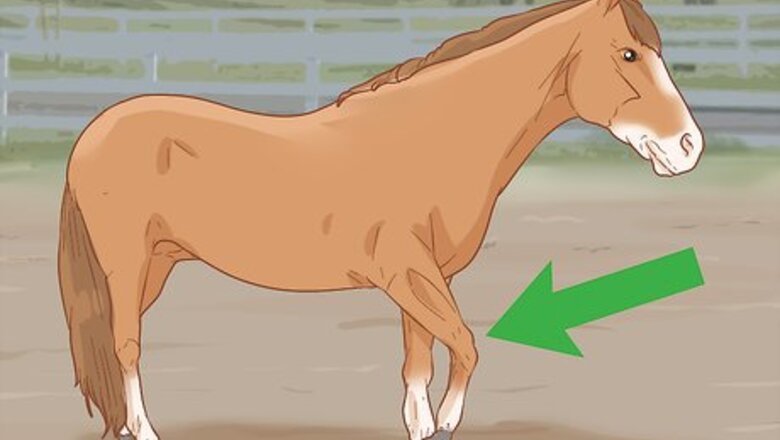
views
X
Research source
Hoof abscesses are very painful, so you should be able to recognize when your horse has a hoof abscess and promptly take your horse to your vet.
Examining Your Horse’s Hoof

Observe if your horse can put weight on the affected hoof. Hoof abscesses occur when bacteria get trapped in the hoof. Pus then builds up, which increases pressure in the hoof because there isn’t much room for the hoof to swell. This pressure becomes extremely painful to a horse, causing it to become lame. If your horse has a hoof abscess, it may not be able to put any weight on the affected hoof. Lameness due to a hoof abscess can occur very suddenly, or it can gradually develop over a few days. The affected foot should be obvious because most horses become very lame and will not bare much, if any, weight on that leg. The horse will start placing just the toe on the ground or holding up the leg entirely.
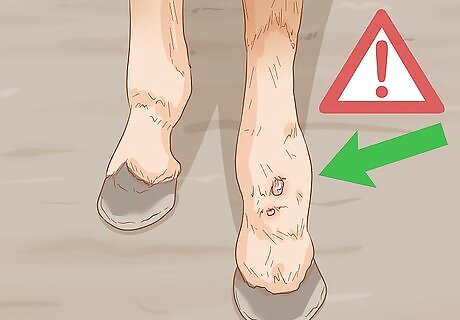
Look for signs of injury on the lower leg. Because hoof abscesses can cause lameness so suddenly, a horse owner may think their horse has a leg fracture. Before examining the affected hoof, look at the lower leg for signs of injury, such as scratches and swelling. Don’t worry if you’re not sure if your horse has a leg fracture. Your vet can determine if your horse has fractured its lower leg through palpation and x-rays.
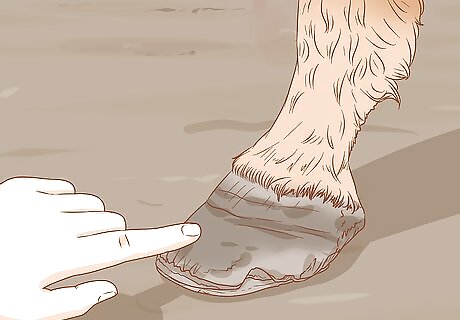
Touch the affected hoof. If your horse has a hoof abscess, the hoof wall will feel warmer than usual. This warmth is a sign of inflammation, which is the immune system’s response to injury or infection. Be very careful when you touch your horse’s hoof wall, since the hoof may be very painful to the touch. If your horse will let you, touch the coronary band (hair line just above the hoof). If the area is warm and soft this can be a sign that the abscess is about to break through here. This area may also be painful if your horse has a hoof abscess. When pressure builds up in the hoof, the pus will travel the path of least resistance to relieve this pressure. This path is usually upwards toward the coronary band, so you may see pus drainage just above the hoof if the abscess has ruptured. If you are having trouble determining if the hoof feels warmer than usual, compare it to the other limb. Be careful when reaching across your horse to feel both hooves and always keep your body in a safe position where you can quickly get up and out of the way.
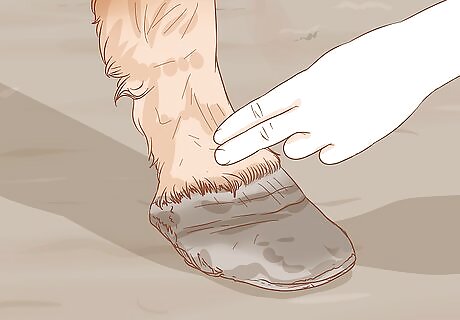
Detect a pulse in the pastern. The pastern is the area on a horse’s lower leg between the hoof and fetlock (lower leg joint). If you put one or two fingers on the back of your horse’s pastern, you will be able to feel a strong pulse. This is because the hoof abscess has caused an increased blood flow to the hoof. As with touching the hoof wall, use caution when touching the pastern. When palpating for a pulse do not use your thumb because your thumb has it’s own pulse. You may end up feeling your own pulse instead of the horse's. You should lightly press your fingers against either artery in the pastern, if there is an increase in the blood flow in that artery it should be easy to feel.
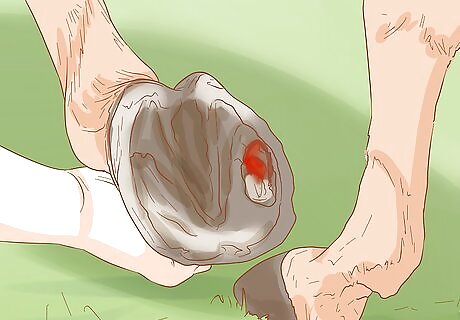
Search for damage to the hoof sole. A hoof abscess can occur if something sharp, like a nail or screw, punctures the sole and creates an entry way for bacteria. If the hoof is soft, bacteria can enter the hoof through the white line (where the hoof wall meets the sole). Bacteria can also gain entry if the sole is brittle and cracked. Gently lift up your horse’s hoof and examine the sole for cracks, softness, or puncture wounds. You may not see any signs of damage or swelling on the hoof. If you do see a nail or other puncturing object in the hoof, do not pull it out. Leave it in so your vet can see the exact point of entry. If your horse is resistant to you touching its hoof, do not continue trying do so. It is better for you to remain safe and have your vet examine the hoof.
Getting a Veterinary Diagnosis

Schedule an appointment with your vet. If you think your horse has a hoof abscess, contact your vet right away. Your horse will likely be in a lot of pain, so taking your horse to your vet as soon as possible will allow for early diagnosis and prompt treatment.

Explain the hoof problem to your vet. During the appointment, give your vet a detailed history of the hoof abscess. Describe when you first noticed your horse’s lameness, and what you saw when you examined the affected hoof and lower leg. The more history you can provide to your vet, the easier it will be for them to make a diagnosis and treatment plan.
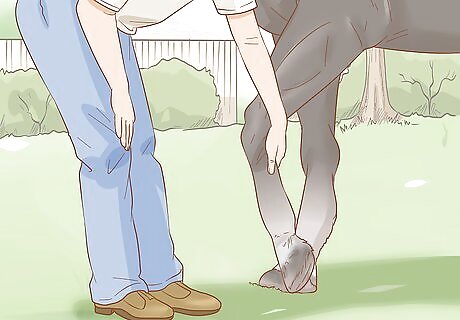
Allow your vet to visually examine your horse. When a horse is lame, an equine vet will perform a detailed lameness exam to determine the cause and severity of the lameness. One aspect of the lameness exam is an overall visual exam of the horse. Your vet will look at your horse to see how it walks and stands, and will take a close look at your horse’s hooves and lower legs to identify abnormalities (e.g., swelling, wounds). Your vet may do this visual exam as you explain the history of the hoof problem. A lameness exam will help your vet rule out other causes of lameness, such as a fracture. This is important, since a hoof abscess can resemble other injuries or illnesses.
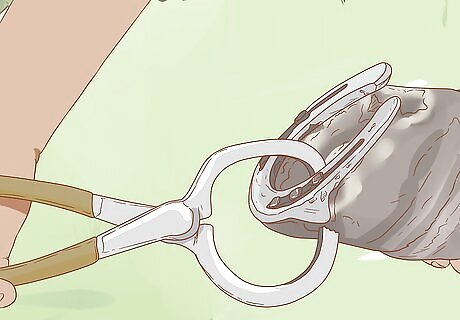
Have your vet use a hoof tester. A hoof tester is an instrument that tests the sensitivity of a hoof to focal pressure. During the lameness exam, your vet will use the hoof tester to apply pressure to different areas of the affected hoof. The part of the hoof that is most sensitive to pressure will indicate the general area of the abscess.
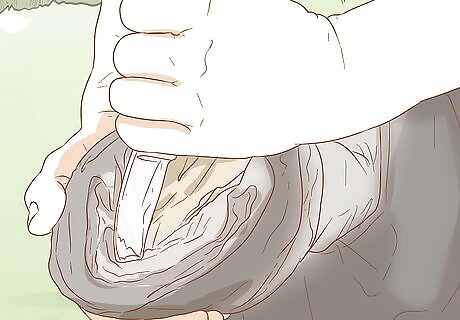
Allow your vet to clean the affected hoof. Once your vet has identified a general area of the abscess, they will want to clean the hoof to identify the exact entry point of the bacteria. Your vet will use a paring knife to scrape away the old sole and clean the hoof.
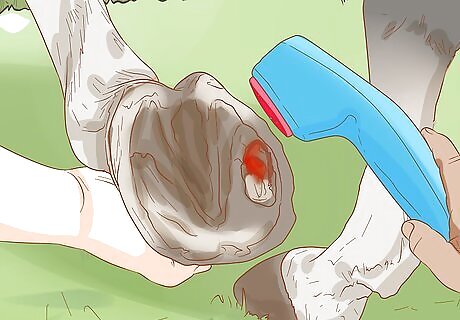
Agree to your vet performing other diagnostic tests. As part of the lameness exam, your vet may want to perform diagnostic nerve blocks. For a nerve block, your vet would inject a local anesthetic into the area around a nerve to block the sensation of everything below the block. This would help your vet localize your horse’s pain and confirm that the pain is in fact within the hoof and not located higher up the leg. Your vet may also want to take x-rays. X-rays can help rule out a leg fracture. Also, if your vet found a sharp object stuck in the sole, they may want to take an x-ray with the object in place to see the path of entry for the bacteria. If your vet cannot find a wound or draining tract in the sole, they may want to take an x-ray to look for pockets of gas, which would indicate the presence of bacteria.


















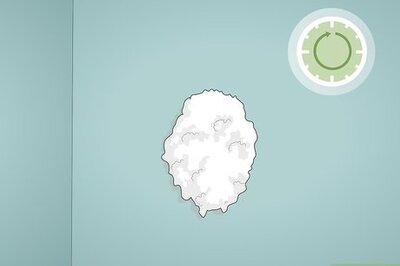
Comments
0 comment